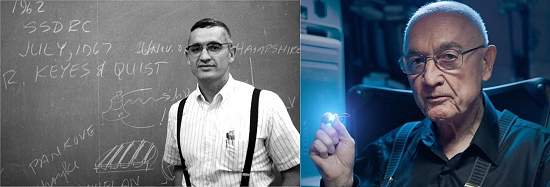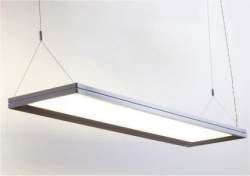O primeiro LED
Em Outubro de 1962, o então jovem doutor Nick Holonyak apresentava ao mundo o primeiro LED (Light-Emitting Diode), um diodo emissor de luz.
Já se sabia que os diodos podiam emitir radiação na faixa do infravermelho, mas ninguém havia ainda conseguido fazê-los brilhar na faixa visível pelo olho humano.
Na época, a pesquisa com semicondutores ainda era emergente e quase uma curiosidade científica, em um mundo dominado pelas válvulas termoiônicas.
O primeiro transístor era um adolescente, e não tinha ainda completado 15 anos de idade.
O primeiro circuito integrado vinha na turma seguinte, com apenas 14 anos.
O primeiro LED custou U$260,00 só em materiais.
Mas os trabalhos com os masers, que levariam à descoberta do laser, fervilhavam, com vários grupos tentando criar dispositivos de estado sólido para a emissão de diversos comprimentos de onda. Devido à sua ligação com a GE, Holonyak queria fabricar um componente semicondutor que emitisse luz visível - em outras palavras, uma lâmpada.

O LED foi apenas a primeira criação do Dr. Nick Holonyak, que tem uma série de contribuições na área. [Imagem: GE/Univ.Illinois]
"O Mágico"
Enquanto seu colega Robert Hall tentava construir um laser semicondutor no infravermelho usando GaAs (arseneto de gálio), Holonyak voltou-se para o espectro visível usando GaAsP (fosforeto arsenieto de gálio).
Em 9 de outubro de 1962, com toda a equipe assistindo, Holonyak tornou-se a primeira pessoa a operar um laser de liga semicondutora na faixa visível - o componente que iluminou o primeiro LED visível.
A equipe passou a chamar o primeiro LED visível de "o mágico", porque, ao contrário dos outros componentes, não era preciso olhar para os aparelhos para ver se ele estava funcionando.
Cinquenta anos depois, os LEDs estão em todos os aparelhos eletrônicos, TVs, monitores de computador, lanternas, semáforos, faróis de carros e uma infinidade de outras aplicações.

Inúmeros pesquisadores ao redor do mundo tentam resolver as deficiências da luz emitida pelos LEDs, que não é tão agradável aos olhos humanos, apesar de suas inúmeras vantagens. [Imagem: GE]
Lâmpada definitiva
O que ainda se espera é que os LEDs realizem a promessa de substituir de vez as lâmpadas incandescentes, que consomem energia demais, e as fluorescentes, que usam o perigoso mercúrio.
Apesar disso, o Dr. Holonyak chama seu pequeno "mágico" de "a lâmpada definitiva": "Porque a própria corrente elétrica é a luz," justifica ele.
Isso significa que um LED opera de forma energeticamente muito eficiente, com pouca perda de energia e uma dissipação de calor desprezível.
O grande entrave à sua utilização na iluminação residencial é que seu espectro de emissão não é contínuo, o que torna sua luz menos agradável aos olhos humanos.
Aos 83 anos, o cientista continua trabalhando na Universidade de Illinois, nos Estados Unidos, sempre em parceria com a empresa GE.
O Dr. Holonyak é responsável também por vários avanços mais recentes na área:
- Transístor a laser produz uma saída elétrica e outra óptica
- Transístor laser está mais próximo da comercialização
- Transistor emissor de luz agora emite raio laser
- Cientistas criam transistor emissor de luz













